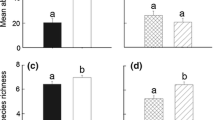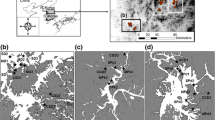Abstract
The conservation of biodiversity is increasingly dependent on human-altered habitats. In a fragmented forest landscape in northern Costa Rica within the Mesoamerican Biological Corridor, an area of great conservation importance, we compared the diversity and composition of ground-dwelling beetle communities in five habitat types along a gradient of increasing disturbance: primary forest, logged forest, secondary forest, plantation (Gmelina arborea) and pasture. Using pitfall trapping we captured a total of 1,877 beetles (Coleoptera), comprising 422 morphospecies in 26 families. The plantation sites had the lowest number of species followed by secondary forest and pasture. Multivariate analysis separated the beetle fauna according to land use, and suggested that only the logged forest maintains a similar species assemblage to primary forest. However, each habitat harboured a number of unique species indicating the conservation value of the mosaic of habitats found in fragmented landscapes. Our results suggest that to maintain forest beetle species diversity it is essential that areas of natural forest are conserved. However, other land uses also provide beetle habitats and in fragmented areas active management to maintain a mosaic of land uses will contribute to the conservation of beetle diversity.
Similar content being viewed by others
References
Abenspergtraun M, Steven D (1995) The effects of pitfall trap diameter on ant species richness (Hymenoptera, Formicidae) and species composition of the catch in a semiarid eucalypt woodland. Aust J Ecol 20:282–287
Andersen AN (1990) The use of ant communities to evaluate change in Australian terrestrial ecosystems: a review and a recipe. Proc Ecol Soc Aust 16:347–357
Basedow T, Krull S (2005) The occurrence of weeds and the composition and abundance of predatory arthropods in newly sown maize fields in the Central Province of Papua New Guinea. J Plant Dis Protect 112:304–311
Brooks TM, Pimm SL, Oyugi JO (1999) Time lag between deforestation and bird extinction in tropical forest fragments. Conserv Biol 13:1140–1150
Carvalho KS, Vasconcelos HL (1999) Forest fragmentation in central Amazonia and its effects on litter-dwelling ants. Biol Conserv 91:151–157
Christie SI, Scholes RJ (1995) Carbon storage in eucalyptus and pine plantations in South Africa. Environ Monit Assess 38:231–241
Colwell RK, Coddington JA (1994) Estimating terrestrial biodiversity through extrapolation. Philos Trans Roy Soc B 345:01–118
Colwell RK (1999) User’s guide to estimates. Department of Ecology and Evolutionary Biology, University of Connecticut, Storrs, 21 pp
Didham RK, Ghazoul J, Stork NE, Davis AJ (1996) Insects in fragmented forests: a functional approach. Trends Ecol Evol 11:255–260
Didham RK, Lawton JH, Hammond PM, Eggleton P (1998) Trophic structure stability and extinction dynamics of beetles (Coleoptera) in tropical forest fragments. Philos Trans Roy Soc, Lond B 353:437–451
Estrada A, Coates-Estrada R, Dadda AA, Cammarano P (1998) Dung and carrion beetles in tropical rain forest fragments and agricultural habitats at Los Tuxtlas, Mexico. J Trop Ecol 14:577–593
Furley PA, Minty CD (1992) Patterns of soil and sediment distribution over coastal and inland mangrove communities. In: Furley PA, Ratter JA (eds) Mangrove distribution, vulnerability and management in Central America. ODA-OFI Forestry research Programme, Contract no. R4736 Department of Geography, University of Edinburgh, Edinburgh, pp 29–45
Goerhing DM, Daily GC, Şekerçioğlu CH (2002) Distribution of ground-dwelling arthropods in tropical countryside habitats. J Insect Conserv 6:83–91
Ghazoul J (2002) Impact of logging on the richness and diversity of forest butterflies in a tropical dry forest in Thailand. Biodiv Conserv 11:521–541
Hammond PM (1994) Practical approaches to the estimation of the extent of biodiversity in speciose groups. Philos Trans Roy Soc, Lond B 345:119–136
Heltshe J, Forrester NE (1983) Estimating species richness using the jackknife procedure. Biometrics 39:1–11
Jullien M, Thiollay JM (1996) Effects of rain forest disturbance and fragmentation: comparative changes of the raptor community along natural and human-made gradients in French Guyana. J Biogeogr 23:7–25
King JR, Andersen AN, Cutter AD (1998) Ants as bioindicators of habitat disturbance: validation of the functional group model for Australia’s humid tropics. Biodiv Conserv 7:1627–1638
Kraenzel M, Castillo A, Moore T, Potvin C (2003) Carbon storage of harvest-age teak (Tectona grandis) plantations, Panama. Forest Ecol Manage 173:213–225
Krebs CJ (1989) Ecological methodology. Harper Collins Publishers, New York, 654 pp
Lawton JH, Bignell DE, Bolton B, Bloemers GF, Eggleton P, Hammond PM, Hodda M, Holt RD, Larsen TB, Mawdsley NA, Stork NE, Srivastava DS, Watt AD (1998) Biodiversity inventories, indicator taxa and effects of habitat modification in tropical forest. Nature 391:72–76
Magurran AE (1988) Ecological diversity and its measurement. Chapman and Hall, London, 200 pp
Oliver I, Beattie AJ (1996) Designing a cost-effective invertebrate survey: a test of methods for rapid assessment of biodiversity. Ecol Appl 6:594–607
Perfecto I, Vandermeer J, Hanson P, Cartín (1997) Arthropod biodiversity loss and the transformation of a tropical agro-ecosystem. Biodiv Conserv 6:935–945
Roth DS, Perfecto I, Rathcke B (1994) The effects of management systems on ground-foraging ant diversity in Costa Rica. Ecol Appl 4:423–436
Rowell DL (1994) Soil science: methods and applications. Longman Science and Technology, Harlow
SAS (1990) SAS/STAT User’s guide, version 6, 4th edn. SAS institute, Cary, North Carolina
Scheffler PY (2005) Dung beetle (Coleoptera: Scarabaeidae) diversity and community structure across three disturbance regimes in eastern Amazonia. J Trop Ecol21:9–19
Schroeder P (1992) Carbon storage potential of short rotation tropical tree plantations. Forest Ecol Manage 50:31–41
Shahabuddin, Schulze CH, Tscharntke T (2005) Changes of dung beetle communities from rainforests towards agroforestry systems and annual cultures in Sulawesi (Indonesia). Biodiv Conserv 14:863–877
Stier SC, Siebert SF (2002) The Kyoto Protocol: an opportunity for biodiversity restoration forestry. Conserv Biol 16:575–576
Storch D, Konvicka M, Benes J, Martinkova J, Gaston KJ (2003) Distribution patterns in butterflies and birds of the Czech Republic: separating effects of habitat and geographical position. J Biogeogr 30:1195–1205
Sutherland WJ (2000) The conservation handbook: research, management and policy. Blackwell Science, Oxford, 278 pp
ter Braak CJF, Šmilauer P (1998) CANOCO Reference manual and user’s guide to canoco for windows. Centre for Biometry, Wageningen, 282 pp
Ukpong IE, Areola OO (1995) Relationships between vegetation gradients and soil variables of mangrove swamps in south-eastern Nigeria. Afr J Ecol 33:14–24
Vasconcelos HL, Delabie JHC (2000) Ground ant communities from central Amazonia forest fragments. In: Agosti D, Majer JD, Alonso L, Schultz T (eds) Sampling ground-dwelling ants: case studies from the world’s rain forests. Curtin University school of environmental biology bulletin No. 18, 75, Perth, Australia, pp 59–70
Watt AD, Stork NE, Bolton B (2002) The diversity and abundance of ants in relation to forest disturbance and plantation establishment in southern Cameroon. J Appl Ecol 39:18–30
White RE (1998) A field guide to the beetles of North America. Houghton Mifflin College Publishing, 341 pp
Acknowledgements
This work was financed by the Department of Geography, University of Edinburgh and the Centre for Ecology and Hydrology (CEH), Edinburgh. Fieldwork was funded by the Carnegie Trust for the Universities of Scotland, the Tropical Agriculture Association, and the University of Edinburgh Small Projects Grant Trust. It would not have been possible without the assistance of CODEFORSA (the Commission for Forestry Development, San Carlos, Costa Rica), particularly Jhonny Mendez and Jose Luis Guzman, MINAE (the Ministry of Environment and Energy, Costa Rica) who gave permission to undertake this research (Licence number 0023108), Manuel Zumbado and others at INBio (National Institute for Biodiversity, Costa Rica), the landowners of the field sites in northern Costa Rica and Julia Vargas for her hospitality during fieldwork. Michelle Jones and John Healey, School of the Environment and Natural Resources, University of Wales Bangor, made valuable suggestions for improving an early version of the manuscript.
Author information
Authors and Affiliations
Corresponding author
Rights and permissions
About this article
Cite this article
Gormley, L.H.L., Furley, P.A. & Watt, A.D. Distribution of ground-dwelling beetles in fragmented tropical habitats. J Insect Conserv 11, 131–139 (2007). https://doi.org/10.1007/s10841-006-9026-9
Received:
Accepted:
Published:
Issue Date:
DOI: https://doi.org/10.1007/s10841-006-9026-9




